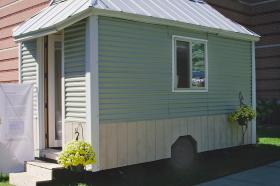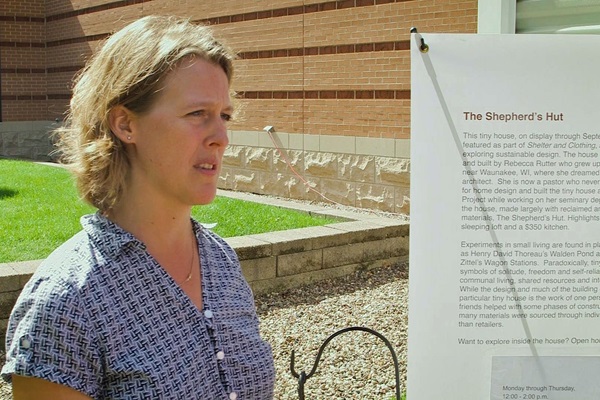Editor's note: Rev. Rutter talks in-depth about all she learned in this process on an episode of our podcast called Get Your Spirit in Shape: Peace Simplicity and a Tiny House. Download the conversation or listen online.
It was a stressful year for the Rev. Rebecca Rutter. The United Methodist pastor was finishing seminary, pastoring a church, and parenting three children. She needed something to help her relax. So she did what any of us would do. She built a tiny house.
“I decided I’m just going to need a way of consistently having time just for myself,” she remembers, “to get away, to go out to the backyard and work on this.” Along the way, she learned important lessons about going green, living simply, and making room for Jesus in her busy life.

Smaller footprint
Rutter developed an interest in designing houses at an early age. As a child, she dreamed up mansions, the fantasies of a youngster.
“As I got a little older,” she continues, “I started realizing that we all have limits in life, and actually limits are a good thing.” That’s when she started challenging herself.
“Let’s see if I can design an 800 square foot house that still has a comfortable space for everything,” she recalls thinking while in junior high school. Designing everything to fit into the tiny house’s 98 square feet was a greater challenge yet.
“Whenever you design or build something,” Rutter explains, “you have to think, what’s the priority here? Do I want more space to have people sit down and sit around a table? Do I want more space in a kitchen? Do I want more space here or there? It really forces you to look closely at priorities, not just for that project, but in life.”
An interview with Rev. Rutter
Rev. Rebecca Rutter shares more detail about constructing her tiny house and what she learned about going green, living simply, and making room for Jesus on Get Your Spirit in Shape: Peace, Simplicity and a Tiny House.

One of Rutter’s priorities is being with people, as evidenced by the tiny house design. The built-in table and benches in the dining area seat six, and there is room for five adults to sleep.
“There’s plenty of space for people to come and hang out,” Rutter explains. “Though you probably wouldn’t want to have more than one or at most two [guests] live there for more than a week,” she cautions.
Rutter’s work on the tiny house caused her to consider priorities in other areas of life.
“I’m learning how…to recognize what I really need to thrive and to be available to what God is calling me to do and prioritize in life.”
Rutter explains that living more simply begins not with focusing on what we will do without, but by being grateful for what we have. Gratitude not only changes our hearts, it also helps us become better stewards of our natural resources.
Going green
Through the years, Rutter’s interest in house design grew to include good stewardship of resources. She taught herself about sustainable architecture, environmentally-responsible construction, and alternate ways of providing energy and water.
When considering building the tiny house, “I thought, this is a perfect opportunity for me to put all of the pieces together that I have been interested in,”she says in an April 2017 podcast episode of Get Your Spirit in Shape.

Building on a budget and wanting to minimize waste, Rutter often made use of leftover material from other projects.
“For instance, all of my metal framing for the house came from somebody’s basement that they had left over from a project,” she reports. “Another thing is all the siding and the roofing that I have on my house were found in my parents' barn from a leftover project.” All of those materials would have probably ended up in a landfill had she not rescued them for her tiny house.
“I think consumption is one of the key problems in what we are doing in our earth,” Rutter explains. “We think that our lives will be happier and more fulfilled if we have more… whatever it is.”
“Our sufficiency, and our joy, and our contentment are found only in Christ,” she continues, “and that takes spending time with God by diving deep into the riches of his Word, in fellowship with other believers, and finding true joy and contentment in loving God and our neighbor. As we do that, all the other things of this world fade in their importance and we’re not as tempted to consume and be materialistic.”
Room for Jesus
As intended, the tiny house project helped Rutter cope with the demands of that very busy season of life. The hours spent building, designing, and problem solving, provided her with “more time to breathe emotionally and spiritually with God,” she says.

“I could go out there and even if I just needed to sit down and be alone for a little bit,” she remembers, “it was a great little time to understand what God was trying to say to me in that still, alone solitude time and place.”
Rutter, who describes herself as a people person, says she continues to make time to be alone and quiet with God today.
Not many of us would design and build a tiny house to help us relax, but there are things each of us can do to better care for earth’s resources and live more simply. The results may mean a smaller footprint, but it can also expand our hearts in love for Jesus and our neighbors.
This story was first published on April 13, 2017.
*Joe Iovino works for UMC.org at United Methodist Communications. Contact him by email or at 615-312-3733.





